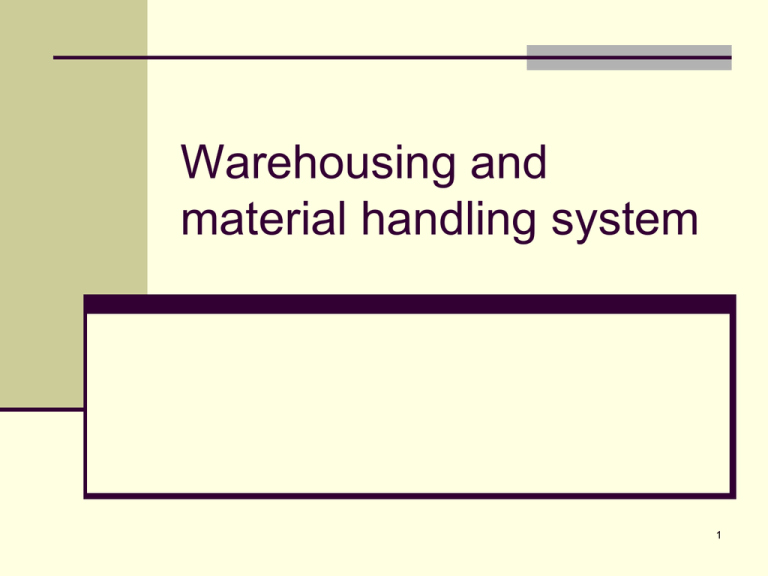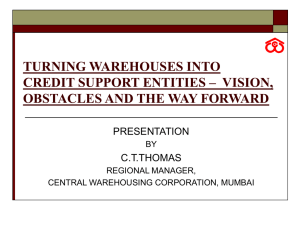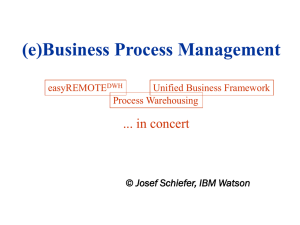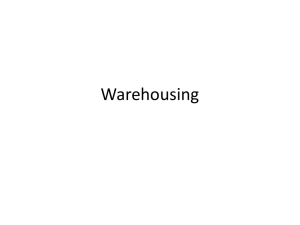1. Warehousing and M..
advertisement

Warehousing and material handling system 1 Training Schedule Type of warehouse Selection of warehouse Discussion Space and layout Discussion - warehouse constraints New concept – virtual warehouse Open discussion 2 Warehousing an integral part of every logistics system providing a desired level of customer service at the lowest possible total cost a primary link between producers and consumers 3 Is this what you are looking for ? 4 In reality 5 Lucky you have this one 6 Cost Trade-offs Required in a Logistics System 7 What is Warehousing? A part of a firm’s logistics system that stores products (raw materials, parts, goods-inprocess and finished goods) at and between point-of-origin and point-of-consumption, and provides information to management on the status, condition, and disposition of items being stored. 8 Warehouse vs DC 9 Warehouse vs Distribution Centre Warehouses: Distribution Centre: store all products hold min. inventory (high handle in four cycles demand items) handle most products in 2 cycles (receive and ship) perform high % of valueadded activities collect data in real-time focus on maximizing the profit impact (receive, store, ship and pick) perform a minimum of value-added activities collect data in batches focus on minimizing the operating costs 10 Why Hold Inventories? - 1 1. To achieve transportation economies 2. To achieve production economies 3. To take advantage of quantity purchase discounts and forward buys 4. To maintain a source of supply 5. To support the firm’s customer service policies 11 Why Hold Inventories? - 2 6. To meet changing market conditions (e.g. seasonality, demand fluctuations, competition) 7. To overcome the time and space differentials that exist between producers and consumers 8. To accomplish least total cost logistics commensurate with a desired level of customer services 9. To support the just-in-time programs of suppliers and customers 12 The role of warehousing in logistics In the past, warehousing was necessary due to the traditional production-oriented ‘push’ system. 13 The role of warehousing in logistics In recent times, however, a market-oriented practice or ‘pull’ system which requires constant monitoring of market needs. In a pull system, warehousing offers improved service to customers by positioning inventory to achieve strategic and operational objectives. 14 Uses of Warehousing Manufacturing support Product - mixing Consolidation Break-bulk 15 Manufacturing support Warehouses function as inbound consolidation points for the receipt of materials shipments from suppliers 16 Product - Mixing Product mixing often involves multiple plant locations that ship products to a central warehouse 17 Consolidation Small orders from a number of suppliers may be shipped to a consolidation warehouse near the source of supply 18 Breakbulk Break bulk warehouses are facilities that receive large shipments of product from a manufacturing plant 19 Factors Influencing Warehousing in the Future Time The best warehouse operations are those designed to reduce every aspect of order cycle time. Quality Users now expect performance that approaches perfection. Asset productivity Reduce total cost, reuse, and recycle. New kind of workforce Requirements for both management and labor will change significantly. 20 Basic Warehousing Decisions 1. Which logistics system design should be adopted? 2. Should warehousing be owned, leased, rented, or some combination of these? 3. Should warehousing functions be subcontracted to a third party? 4. Should new materials handling equipment, or use labour intensive materials be installed? 5. How much capacity is required? 6. Where should warehouses be located? 7. What type of warehousing layout is appropriate? 21 Materials to handle 22 Poor design of the warehouse 23 Poor design of the warehouse 24 Types of Warehousing Direct Store Delivery (market products directly to customers) Public Warehousing (to rent space) Private Warehousing (to own or lease space) 25 Six types of Public Warehousing General Merchandise Warehouses for manufactured goods Refrigerated or Cold Storage Warehouses Bonded Warehouses Household Goods and Furniture Warehouses Special Commodity Warehouses Bulk Storage Warehouses Other options Cross-docking Contract Warehousing 26 Warehouse vs Cross dock 27 Cross dock 28 Advantages of Public Warehousing 1. Conservation of capital 2. Use of space to meet peak requirements 3. Reduced risks 4. Economies of scale 5. Flexibility (size and location) 6. Tax advantages 7. Specific knowledge of storage and handling costs 29 Disadvantages of Public Warehousing Effective communication may be difficult because of system incompatibility Specialized services may not always be available. Space may not be available on demand. 30 Advantages of Private Warehousing 1. Control 2. Flexibility (design and operation) 3. Less costly 4. Better use of human resources 5. Tax benefits 6. Intangible benefits 31 Disadvantages of Private Warehousing Flexibility (fixed size and location) Investment 32 Size and Number of Warehouses The size and number of warehouses facilities are interrelated decisions They typically have inverse relationship The general trend is to have fewer, but larger warehouses 33 How Size is Measured? Size is often defined in terms of square footage of floor space Sometimes, in cubic space of the entire facility 34 Factors Affecting the Size 1. Customer service levels Higher the level, carry more stock 2. Size of market (served) Wider the market, carry more stock 3. Number of products marketed Full range of product need more space 4. Size of the products Bulky one requires more space 5. Materials handling system used Prepare turn round basin, aisle width 35 Factors Affecting the Size 6. Throughput rate (i.e. inventory turnover) dedicated location for package/dispatch 7. Production lead time 8. Economies of scale 9. Stock layout 10. Aisle requirement 11. Office area in warehouse 12. Type of racks and shelves used 13. Level of pattern of demand 36 Warehouse Storage Area Sizing 1. Obtain monthly sales projection in the planning period 2. Convert sales revenue into volume by product group by months 3. Get the average inventory volume by considering turnover rate 4. Sum the total volume 5. Convert into area requirements by dividing the total volume by ceiling height 6. Discount by the utilization factor: aisle, gangway 7. Once a monthly figure on area requirement is obtained, a range of sizes is obtained 8. Match the range with the sales volume. Anything over a particular size is outsourced 9. Quantify the use of private and outsourced warehouse in dollars 10.The size that results in the least total warehouse operating expenses is the right size 37 The Relationship of Demand to Warehouse Size 38 Determinants of Storage Space Requirements These Situations Decrease the Need For Storage Space These Situations Increase the Need for Storage Space Decrease in production or sales Market or company expansion Decrease in number of SKUs Shorter product life cycle Less volatile demand (including longer Increase in number of SKUs product life cycles) Customer handles store delivery Smaller manufacturing lot sizes Smaller purchase amounts Higher inventory turns Better information Quicker transportation Cross-docking Carrier performing consolidation Direct store delivery on a quick response basis Elimination of distributors Expansion into specialized products Import/export items Lengthened production process Increase in minimum manufacturing lot size Requirement for faster response time Inflation/forward buying 39 Deciding Number of warehouses Four Factors: 1. Cost of lost sales 2. Inventory costs 3. Warehousing costs 4. Transportation costs 40 Relationship Between Total Logistics Cost and the No. of Warehouses 41 Break for 10 minutes and Classroom Discussion 42 Selection of Warehouse Location 43 Basic Warehousing Decisions 1. Which logistics system design should be adopted? 2. Should warehousing be owned, leased, rented, or some combination of these? 3. Should warehousing functions be subcontracted to a third party? 4. Should new materials handling equipment, or use labour intensive materials be installed? 5. How much capacity is required? 6. Where should warehouses be located? 7. What type of warehousing layout is appropriate? 44 Reasons for Site Seeking 1. It is necessary to relocate an existing warehouse operation (e.g. end of lease) 2. The business is expanding and must move inventory into a new market 3. More warehouse space is needed to accommodate a growing inventory 4. Contingency planning requires some decentralization of existing warehousing – in other words, there are too many eggs in one basket 45 Location Selection Decision The Macro perspective examines the issue of where to locate warehouses geographically to improve the source of materials and the firm’s market offering. The Micro perspective examines factors that pinpoint specific locations within the larger geographic areas. 46 Macro Approach 1 1. Market Positioned Warehouses 2. Production Positioned Warehouses 3. Intermediately Warehouses 47 Macro Approach 2 1. Product Warehouse Strategy The firm places only one product or product grouping in a warehouse. 2. Market Area Warehouse Strategy Each facility stocks all the firm’s products so that customers can receive complete orders from a single warehouse. 3. General Purpose Warehouse Strategy Facilities carry a full line of products that each warehouse serves all markets within a geographical market. 48 Macro Approach 3 Approaches based on distance and cost minimization The optimal site should minimize the total transportation costs including the costs of transferring raw materials to the plant and the costs of transferring finished goods to the market. 49 Macro Approach 4 Infinite Set Approach: Centre of Gravity Method Feasible Set Approach: Load Distance Model Scoring Model Transportation Method Approaches are often used together 50 Factors in Retail Location Proximity to customers Location is everything 51 Grid-Map Coordinates y n x= i=1 1 (x1, y1), W1 3 (x3, y3), W3 y3 x1 x2 x3 x yiWi i=1 y= n y1 xiWi i=1 2 (x2, y2), W2 y2 n Wi n Wi i=1 where, x, y = coordinates of the new facility at center of gravity xi, yi = coordinates of existing facility i Wi = annual weight shipped from facility i Center-of-Gravity Technique Locate facility at center of geographic area Based on weight and distance traveled Establish grid-map of area Identify coordinates and weights shipped for each location 53 Center of Gravity Method The center of gravity method is used for locating single facilities that considers existing facilities, the distances between them, and the volumes of goods to be shipped between them. This methodology involves formulas used to compute the coordinates of the two dimensional point that meets the distance and volume criteria stated above. 54 Center of Gravity Method Where: Cx = X coordinate of center of gravity Cy = Y coordinate of center of gravity dix = X coordinate of the ith location diy = Y coordinate of the ith location Vi = Volume of goods moved to or from ith location 55 Example of Center of Gravity Method Center of gravity method example Several automobile showrooms are located according to the following grid which represents coordinate locations for each showroom. Question: What is the best location for a new Z-Mobile Warehouse / temporary storage facility considering only distances and quantities sold per month? 56 Example of Center of Gravity Method 57 Example of Center of Gravity Method 58 Center-of-Gravity Technique - exercise y x y Wt 700 C 600 Miles 500 (135) B (105) 400 300 200 D (60) A (75) 100 0 100 200 300 400 500 600 700 x Miles A 200 200 75 B 100 500 105 C 250 600 135 D 500 300 60 Center-of-Gravity Technique - answer y 700 C 600 Miles 500 (135) B (105) 400 300 200 A x y Wt Center of gravity (238, 444) D (60) (75) 100 0 A 200 200 75 100 200 300 400 500 600 700 x Miles B 100 500 105 C 250 600 135 D 500 300 60 Load Distance Technique Establish a grid with the respective locations Compute Load x Distance for each site Choose site with lowest load x Distance Distance can be actual or straight line 61 Example of Load Distance Technique 4 suppliers will supply goods to your warehouse. You have identified 3 potential sites for your warehouse. Which one will be most suitable? 62 Example of Load Distance Technique 63 Example of Load Distance Technique 64 Example of Load Distance Technique 65 Micro Perspective – Private Warehousing Quality and variety of transportation carriers serving the site Quality and quantity of available labor Labor rates Costs and quality of industrial land Potential for expansion Costs of construction Costs and availability of utilities Cost of money locally Local government tax allowances 66 Micro Perspective – Public Warehousing Facility characteristics Warehouse services provided Availability and proximity to transport terminals Availability of local cartage Other companies using the facility Availability of computer services and communications Type and frequency of inventory reports 67 Schmenner’s Eight-Step Approach 68 Scoring Model - Factor Rating Method A location decision involves both qualitative and quantitative input. It is useful both for evaluating and comparing alternatives. The method allows decision makers to incorporate their subjective judgments and quantitative information into the decision process. 69 Factor Rating Method Six-step procedure of factor rating method 1. 2. 3. 4. 5. 6. Determine which factors are relevant (e.g. location of market, water supply, parking facilities, revenue potential) Assign a weight to each factor, indicating its relative importance compared to all other factors. Typically, weight the sum to 1.00 Decide on a common scale for all factors (e.g. 0 to 100) Score each location alternative Multiply the factor weight by the score for each factor and the total results for each location alternative Choose the alternative that has the highest composite score 70 Factor Rating Method Example Two warehouses (A and B) are assigned the following values and respective points, where the more points the better for the site location. 71 Transportation Method Transportation method seeks to minimize total transportation costs of shipping products from m sources to n destinations Each source has Ai units of resources available and each destination in need of Nj units of resource. The cost of allocating one unit of resource from source i to destination j is Cij 72 Transportation Method Five-step procedure of transportation method 1. State the problem so that the total no. of shipments available equals to the no. of shipments needed 2. Create an initial solution 3. Evaluate the solution for improvement 4. Modify the solution accordingly 5. Repeats steps (3) to (4) until no improvement is possible 73 Example of Transportation Method 74 Natural Selection In the real world, surveys have shown that distribution centres are often concentrated around a small number of major centres An analysis of 29 food manufacturers showed two thirds of their stockholding points were within 20 miles of nine cities : London, Bristol, Glasgow, Birmingham, Manchester, Newcastle, Leeds, Nottingham, Southampton Can we conclude that through time firms converge on optimal or near-optimal locations by a process of trial and error....? 75 Q&A 76









